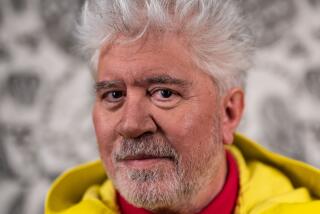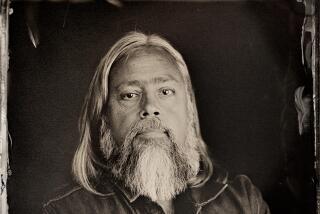Review: Alex Tizon sizes up his masculinity in memoir ‘Big Little Man’
You have to wait until the eighth chapter of Alex Tizon’s remarkable memoir, “Big Little Man: In Search of My Asian Self,” for confirmation that his title is the reference you’ve been hoping it isn’t and fearing it is. All of the book has been leading up to this big (little) reveal.
What began as yet another spare, evocative rumination on ethnic identity has been for seven chapters cascading toward the barely concealed anxiety roiling at the center of the book.
We have learned by now that in his adolescent years, Tizon wore many ethnic costumes in his quest for masculine identity — from “white suburban frat boy” to “swivel-hipped Latin lover, a Puerto Rican hipster, a Mexican street fighter, a Native American soothsayer” (“the only suits I avoided were Asian ones”) — and that watching television and going to the movies can be an excruciating experience, one he approaches with bated breath lest he see himself denigrated afresh in images of the Asian man as “houseboy,” “order taker,” “spectators,” “sage,” “brainiac” or “martial artists” who “keep their genitals in their pants” and seldom deviate from their assigned roles as “the runts of the human race.”
FOR THE RECORD:
“Big Little Man”: A June 29 review of the book “Big Little Man” said that author Alex Tizon is in his 60s. He is 54. Also, the review described Tizon as an avid consumer of porn, but the book says the viewing was for research. It also describes Tizon’s friend’s embarrassment about the size of his endowment, whereas the book states that “he liked being average.” —
He has described his parents’ “adulation for all things white and Western,” which led them to believe that “White was the apex of humanity, the farthest point on the evolutionary arc and therefore the closest earthly representation of ultimate truth and beauty” — a belief Tizon now views as the “engine of their self-annihilation.”
He has listed a catalog of prominent Asian women who are married to white men and described the “Asian fetish” that embodies the view — left over from the era when Asia became a sexual playground for Europeans — that “Oriental girls existed to be consumed by men.” He has interspersed ably written potted summaries of Asian and Asian American history amid his memoiristic musings. But these talking points are prologue to the larger issue Tizon wishes to expose.
“Like every young man in the Western Hemisphere,” he writes, “I had put a ruler to my penis, hoping to get a read on my place in the world order.” His penis, he reports, is 6 inches long, though his own self-perception, distorted by the myth of under-endowment wrongly — wrongly! — maliciously! — and wrongly! — ascribed to Asian men, causes him to see himself as smaller than the ruler has shown him to be.
In other words, Tizon has a bad case of penile dysmorphic disorder. His member is in fact perfectly average, though for avid consumers of pornography such as himself, “average is the new tiny.”
A Pulitzer Prize-winning journalist formerly at the Seattle Times and the Los Angeles Times, Tizon has gone where many Asian men have gone before in boastful or defensive or self-deprecating locker room banter but seldom in a memoir by an accomplished adult in his 60s.
Tizon might have been forgiven for writing in his emeritus years yet another earnest celebration of the American Dream fulfilled. Instead, he has written a painfully candid first-person account of the inferiority complex that can overtake a colonized people, in all of its dimensions.
“The size of American bodies came to represent American capacities in everything we desired,” he writes. “They were smarter, stronger, richer; they lived in comfort and had the surplus to be generous.” By contrast, Tizon’s Filipino family and peers were “[s]mall in everything. … We were undernourished and scrawny, our genetics revealing not-so-distant struggles with famine and disease and war.”
He describes comparing the penis lengths with his best childhood friend and competing with him in the distance they could ejaculate. He recalls the embarrassment of a black friend with a modest endowment and critiques the folk illogic that posits an inverse relationship between intelligence and penis size.
For Tizon, this all connects to an implicit (and false!) schema present throughout popular culture, in which the black man is alleged to have a huge member and a tiny intelligence and the Asian a huge intelligence and a tiny member, leaving the white man as the ideally proportioned figure midway between two poles of human extremity.
The arc Tizon ultimately imposes on the book feels a little forced, the remedy to his malady less vivid than his description of the malady itself. He travels to Asia, learns for the first time of the imperial preeminence that once belonged to China and that the “softer, cerebral man is of a higher order than the harder, martial man” in traditional Chinese views of an ideal masculinity. He looks forward to the day when the rapidly closing gap in average Asian and American heights is entirely effaced.
He marries a fellow Filipina (after a failed marriage to a white woman) and gains self-esteem from witnessing the rise of Asia and the emergence of Asian and Asian American business magnates, athletes and media figures as well as the growing number of “self-possessed, socially promising, and physically substantial young Asian standouts” who excel at sports and date women of all ethnicities.
A Korean American college football player named Aaron Lee incarnates for Tizon a vision of masculine power and efficacy that both assuages and redoubles his melancholy. “[I]t just seemed,” he writes, “as if his face was perfect. … A face I would design if I could design a face for the son I was never going to have.”
Yet rather than tell Lee about his own youthful struggles with appearance, Tizon falls silent. “He might not have been able to relate to the hole which I’ve imagined swallowing so many generations,” he reflects, “and which I’ve spent my life trying to rise out of. His children and grandchildren may never know such a hole ever existed.”
Yang is a contributing editor at New York Magazine.
Big Little Man
In Search of My Asian Self
Alex Tizon
Houghton Mifflin Harcourt: 272 pp., $27
More to Read
Sign up for our Book Club newsletter
Get the latest news, events and more from the Los Angeles Times Book Club, and help us get L.A. reading and talking.
You may occasionally receive promotional content from the Los Angeles Times.








